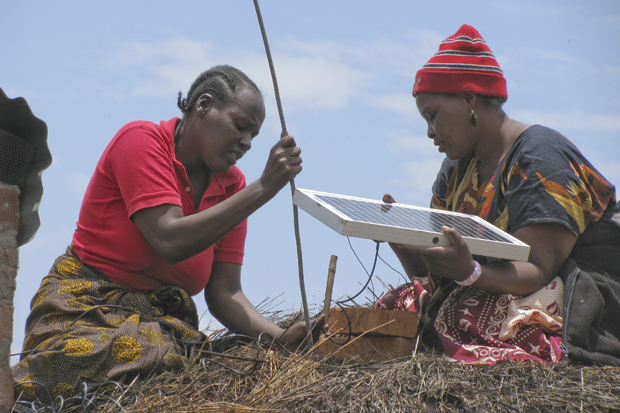Physicist Bob Lange helping East Africa go green
He's back because home base is still here, and because he wants to drum up support for his work
Bob Lange took a round-about way from his job as a Brandeis physics professor to the half- hut on the Usdan lawn from which he’s been demonstrating a solar installation and high-efficiency stove of his own invention over the last several weeks. His route led through prominent educational consultancies, numerous political causes and months of exacting mental and physical work in the cities and villages of East Africa.
Lange's final talk and demonstration in the Usdan structure, which he built with the help of supportive students and faculty, will be at 3 p.m. Tuesday, Nov. 30, as the Brandeis Climate Change Campus Weeks move toward conclusion at a Green United Gala in Levin Ballroom on Wednesday night, Dec. 1.
Schooled at CalTech, Harvard and Oxford, the long-haired, sometimes gruff, usually grizzled Lange was an assistant, then an associate, professor of physics at Brandeis from 1965 until 2008. He now has emeritus status, and is fully concentrated on his stove, the latest in a line of stoves he has invented, improved and installed in Tanzanian villages over the last three and a half years.
He’s come back because home base is still here, though his stays in Africa have grown progressively longer and more frequent. He’s also trying to drum up interest in the stove, the solar rig, and the concept that people in remote and less-developed communities can contribute to slowing climate change and can also benefit in other ways from greening their energy consumption.
By the late ‘80s and early ‘90s, Lange was well-established at Brandeis and also was doing educational consulting for a wide range of clients –- from Roxbury Community College to the Aga Khan Foundation to the Government of Malawi and the World Bank.
In the mid-‘80s, he fulfilled a longtime desire to spend a sabbatical in “the so-called Third World.” Then he set about building on that experience.
He had taught physics at the University of Dar es Salaam in 1986-87 under department chairman Mohammed Bilal, who in early November was elected vice president of Tanzania. Bilal asked Lange to help start a science education camp for children in Zanzibar. From then until 1995, Lange spent two months a year in Zanzibar.
As Bilal moved up the political ladder, Lange took on increasing responsibility for the camp. He formed a nonprofit corporation to receive donations, began helping others “who were in harmony with my spirit and principles” with their fundraising, and in this way met Gemma Enolengila, a British woman married to a Maasai who was doing educational and cultural work in Tanzania with her husband.
Also in East Africa, he helped Robert Van Buskirk, a similarly peripatetic physicist-activist-environmentalist whom Lange knew from Van Buskirk’s student days at Harvard, set up an e-mail system for the newborn country of Eritrea.
“Robert had this idea for combining solar installations and wood stoves,” Lange recalls. “ The generic idea is to help local people do something that is good for them and good for the world. In return, they would get something that could only be obtained with hard currency, which they lacked.”
Van Buskirk was trying out the idea in parts of Africa he knew well, and proposed that Lange do the same.
“I was getting to know the Maasai through this Gemma, ” Lange recalls, “and she said ‘what about introducing the stove and solar project with the Maasai?’ So I went to this sort of Maasai cultural drop-in center she had in her home in [the northern Tanzanian city of] Arusha, and started going out to the Maasai villages.
“They lived in the darkest, smokiest houses you can imagine,” says Lange. “Very unhealthy.”
It was an ideal setting for the project. Lange’s idea was to reduce deforestation, carbon emissions and indoor air pollution by helping the Maasai build efficient stoves with chimneys to clear the smoke from their dwellings. It also would reduce women’s fire-wood gathering hours.
Those who bought – more about that in a minute -- and built the stove would get a solar collector array for their roofs strong enough to light a bulb, charge a cell phone and charge a radio battery.
Only problem was, the right stove did not yet exist. Lange had to invent it.
“The difficulty was building a stove that would both keep smoke out of the house and have good cooking efficiency,” Lange said. “It was a real engineering problem. It took a long time, and I made a lot of mistakes.”
For a while, every time he thought he had a solution “I’d try boiling some water and the Maasai women would say ‘Grandpa, that’s just taking too long.’ I redesigned it and redesigned it, in the field and in my backyard in Cambridge.”
Those interested in the stove-solar proposition have to pay about $35 – about two and a half goats in the Maasai context – to defray the $50 cost of the stove. The solar installation is free to the Maasai.
What Lange most needs now is to increase the scale of the project. He currently has nearly 200 stoves in place; he says he needs to get the total number to 1,000. That, he says, “is the point at which we can do serious statistical analysis of how well stoves are sustained and maintained, and how businesses in the supply stream benefit – how this helps the economic environment as well as individual households. That’s very important to major donors – they all talk about business creation."
Categories: International Affairs, Science and Technology






